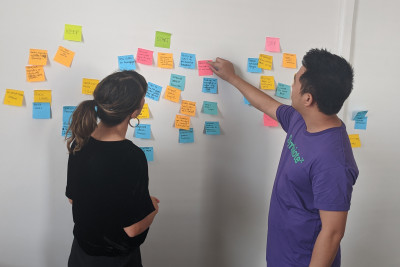Why including Developers in UX research leads to better outcomes
Published Nov 30, 2021, 7:00 AM
We included a web developer right from the start in a recent extranet project – here’s what he had to say about the experience.
Including web developers right from the beginning of a project makes a lot of sense
I’m sure I’m not the only web developer who’s had a project manager brief them on a job by handing them a spreadsheet with 500 rows and seven tabs, saying ‘Here’s the project scope. Let me know if you have questions.’
Thankfully that doesn’t happen at Symbiote, but when it’s happened to me in the past I’ve found it challenging, especially when I’ve been new to a project or had zero communication with clients.
On a recent project, the UX team involved me right from the beginning. I joined the team to meet the people we were designing for, and learn what their jobs entailed. This gave me entirely new insights I wouldn’t have gained if I were just reading a briefing spreadsheet.
Their ten-year-old extranet was slow and didn’t give them the information they needed
Our clients were finding it difficult to find relevant information on their creaky 10 year old extranet website. It loaded really slowly, and search functionality wasn’t giving them the results they needed. They had a lot of contradictory information due to lack of version control of the pages, articles, or news. Any time they wanted to publish information they had to use third party software to get this information to their colleagues. Considering that their entire job was based around answering questions from their customers, their outdated extranet made it seriously hard work to get people the information they needed.
It was incredibly valuable to see for myself how people used their website, switching tabs, opening and closing pages while customers were on the end of the line.
Seeing the way our clients used their existing system was invaluable for me as a developer
I joined a few meetings involving clients, end users, and product owners. We had a co-design session that allowed people to rant and share their frustrations. I also sat beside a call center operator and listened to their conversations with customers as they collected information – page by page with almost impossibly fast typing – so they could give exact information to their customer on the phone call. Watching how slowly their pages loaded, how the information looked and was used, how much time they spent scouring pages for information … it was horrible.
Rachel, our UX designer, used all the information we collected to meticulously design a dashboard to suit the users’ needs. I built in the functionalities with the mindset of both developer/end-user. This helped a lot in decision making in either building a piece of UX functionality or API endpoints to help reduce the loading time of the page and other factors that we have picked up from the co-design and sessions and researches.
This strengthened my original motivation to become a developer – I like to help people
Watching the way these workers used their extranet – and what their jobs were like – reminded me of why I originally became a developer: I wanted to build better websites to help people through digital information in this new age.
It’s satisfying to see how this project is progressing. I’ve heard that people love how easy it is now to favourite a page, article, or news via the toolkit we created, and to access them quickly when needed. People are now using the new search functionality, banners, weather information, and notifications effectively, as well as using the widgets we created to give them a dashboard.
It is so satisfying to hear those things and to think that I improved their workflow. In this case, the seemingly small decision to involve a developer at the beginning of the project made a huge impact in the end product – and how it improved people’s ability to do their jobs.


